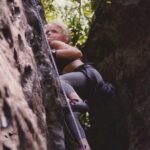In this complete guide to deadpoints, you’ll learn how to deadpoint like a pro and master the range of techniques behind the movements to become a better climber.
When you see elite climbers like Adams Ondra, Alex Megos, etc, up on the walls, you can’t help but notice how gracious and elegant they move between holds.
However, behind the scenes are coordinated dynamic movements that assist in their ability to tackle advanced boulder problems and maintain elegance while at it.
This skill is termed ‘deadpoint’. The deadpoint can be super challenging and takes a lot of practice to master—especially as a beginner climber.
For this reason, in this article, we go on to break down all you need to know about the deadpoints. Read on to learn more about how this climbing technique works and the steps to deadpointing correctly. Hey, you may also learn how easily you can wash your climbing shoes.
What Is Deadpoint Climbing? Principle Behind It
Deadpointing is simply a range of controlled dynamic movements where you skillfully ascend steep walls; maneuvering your way up those foot and hand hold.
Usually, it is the next practical option when you feel stuck with your body fully extended and moving statically to the next hold seems impossible. As a result, you fight to avoid losing your footing and falling off. This controlled dynamic movement is a critical technique every climber needs to master to be able to tackle problems and progress.
Technically, you must be fully committed and willing to let go and leap towards the next hold to move further. The moment you want to land on the next hold should be done at the peak of the dynamic movement. This is where you experience a brief moment of weightlessness known as the deadpoint.
For instance, picture a tennis ball thrown up in the air. At the peak of height, you’d notice a slight pause right before the ball starts to fall back down due to gravity. That slight pause at the peak height before the ball falls back to the ground is what we term ‘deadpoint’ in climbing.
When executing this dynamic movement, keep in mind that your timing must be accurate so you can easily grab the target hold without falling. If you jump a little too early or late, you find it hard to grip the next hold and end up succumbing to the downward pull of gravity.
Unlike dyno, both your legs and arms are suspended in the air and not in contact with the walls. However, in deadpointing, there’s always a body part in contact with the wall with one hand reaching for the target hold.
Main Benefits Of Deadpoint
Climbers rely on this climbing technique as it helps progress further without having to experience early muscle fatigue.
In addition, it also hastens climbing speed while reducing your muscle tension time.
How To Master The Deadpoint Technique
Now that you know what the deadpoint is, let’s explore the simple – yet critical – strategies you can use to deadpoint correctly below:
Firm Placement Of Your Feet
The first step you must learn to do when deadpointing is knowing how to initiate movements from your feet. This is the first step to nailing the deadpoint technique.
Generally, the feet generate more explosive power than the arms can. For this reason, you must concentrate your weight on your foot and not your arms. In other words, learn to fix your foot firmly and press hard on the footholds to provide the required upward push of your whole body.
Thrust Your Hips Towards The Wall
With your foot fixed against the holds, shove your hips inwards so that your body is in close contact with the wall. This position is quite essential when deadpointing and determines how well you hold up on the wall without falling.
By thrusting your hip inwards, you find it easy to direct your movement towards the correct path; making it easier to grab the target hold. In addition to that, it increases your stability on the wall and you spend less energy.
Make sure to focus your center of gravity right below the holds while maintaining a crouched position. Likewise, keep your legs fully extended remembering to press firmly on the foot holds with your foot.
While in this position, you must rock your hips back and forth in a particular range of motion. Keep in mind that the motion of your hips is what you need to progress—not your arms.
Extend Your Body And Latch Onto The Next Hold
You’ve successfully executed the previous steps. Now, the aim is to propel your body to grab onto the target hold with your hands. It’s typically a make-or-break situation, so you want to get it right.
More so, there’s no going back at this point. What you do now is fight not to succumb to the intense force of gravity pulling you downward. Take advantage of the brief moment and latch onto the next hold. Ensure to keep your eyes focused on the target hold before the jump.
On top of that, be sure your torso is tightened and your arms relaxed all through the entire movement. Particularly when on steep walls. If your arms contract, fatigue quickly occurs and you’re prone to fall.
Constant Practice
As with anything else, becoming a better climber not only takes time but also, intense practice on your part. Don’t stop practicing even if you fail on the first, second, or even third attempt.
For starters, a good nearby climbing gym is a good way to practice and master the moves. You can enroll in one to practice until you start to get better and make glaring progress.
BOTTOM LINE
Deadpoint is, no doubt, one of the most important techniques to master as a climber. It automatically becomes the next best option when we need to climb challenging routes.
Above all, these dynamic moves and the ability to maintain body tension are what define your skill as a climber.
Now you’ve learned the nuts and bolts behind the deadpoint technique and how to master them. With accurate timing and body tension coupled with momentum and skillful footwork, the rewards are worth the risks and utterly satisfying. And, on top of that, highly beautiful to watch.






